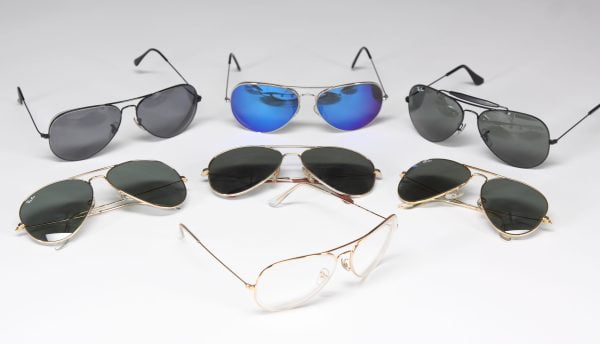
When it comes to designer eyewear or fashionable glasses, you can’t make so many choices. Depending on your persona, attire, and appearance, you can either go for custom-made rims or designer glass manufacturers.
Today, we discuss two of the most influential yet, at-edge companies that have always grabbed attention in the designer glasses industry. Those two are none other than Warby Parker and Luxottica.
Warby Parker vs Luxottica
Warby Parker and Luxottica, though distinct in their philosophies and strategies, share a common goal: providing stylish eyewear to consumers. Both brands have had their fair share of fame, media, and press. But what is it that crucially derives such a tussle like Warby Parker Vs Luxottica? We’ll dig deep down into both the brands, their core values, and what sets them apart. But, first, let’s unravel what all the fuss is about!
Warby Parker
As the premier one-stop prescription glasses retailer for more than 200 million adults in the US, Warby Parker has definitely made a name for itself. Over the years, the brand has established a certain sense of trust and credibility among its customers.
This has led to a massive user base of the brand, who are willing to pay 127$ on average for each of their luxury frames.
Retail Locations & Online Shopping
Based in New York City, the retail chain boasts 71 physical shops spread out through 28 states in the country. The shops are not only retail destinations but also experience centers. You can try on glasses, take tests to determine your measurements, update your prescription, and so much more.
As an easy alternative to physical shopping, Warby Parker also offers an online retail experience. Just log on to their user-friendly website, and you can get on with your order right away, provided you have a valid prescription. What’s more, you can pick up your order in any of the 71 retail spots or have it delivered right to your doorstep!
Catalog Options
If we take a look at their more comprehensive range of catalogs, Warby Parker literally has a plethora of options.
Besides the standard polycarbonate lenses with blue-light responsive features, the retailer also boasts of manufacturing 1.67 and 1.74 high-index lenses. Unfortunately, however, there are currently no bi-focal lenses on offer from them.
Most frames and rims from Warby Parker are made of either lightweight plastic or Acetate. It makes the glasses easy to wear but lacks in durability. If you’re looking for a more durable option, they also offer traditional metal rims.
Contact lenses from Warby Parker are also widely popular. They are commonly referred to as their brand name, Scout. Thanks to the innovative CentraForm technology used in their lenses, you can enjoy smooth edges and ultra-clear vision.
As a bonus, all their products are 100% environmentally friendly. For example, sunglasses, lenses, and frames – all arrive in an eco-sustainable package that’s also attractive as a present.
Who makes Warby Parker glasses?
Originating from humble origins, Warby Parker takes immense pride in its sources and manufacturing process. The company was established with the sole purpose of beating the existing high-price market dominated by competitors like Luxottica.
The cheap cellulose acetate and ultra-lightweight titanium material used in their frames are sourced from Italy. A small family-owned business in Europe is the sole distributor of this premium material.
After getting the preliminary design done by their in-house designers at Headquarters, the blueprint is set out for prototyping by the engineers. Then, using a high-tech CNC machine, manufacturers of eyeglasses cut the raw material into face fonts and tumble it with wood chips. Then they finally use the German wax compound to hand-polish the frame.
A group of designated quality checkers ensures the quality of every custom-made frame manufactured only after your order. Then, after final inspection and bench-alignments, the packagers wrap it up in trademark eco-friendly boxes and ship it to you.
Where are Warby Parker glasses made?
Like we said earlier, all of the Warby Parker glasses are made entirely on a custom-order basis. No one frame is the same as the other. Each frame and lens is unique in its truest sense.
While most of the raw materials are sourced from a family-owned business in Italy, a lot of the assembly goes on in factories over in China.
It’s true that a vast majority of the competing brands also make their glasses in China. But Warby Parker has a neat advantage that puts them in front of the competition.
By deploying a sturdy supply chain and good communication network, Warby Parker can cut out the middleman and bring down prices to a bare minimum.
As a result, the product that reaches you from Italy to China to the USA is 100% free from any unnecessary premiums or taxes.
Is Warby Parker overpriced?
Warby Parker has been notoriously known to be a bit on the higher end of the price spectrum. However, we would not necessarily call it overpriced.
Owing to its massive scale of retail operations, online shopping, and mass manufacturing facilities, Warby Parker is able to keep the price down from a lot of other competitors. As a result, you can expect a decent quality basic prescription frame made from them at around $95.
With some extra bucks, you can also opt for the 1.67 high-index lens or 1.74 high-index lens. That will bring up the cost to about $130-$230. Light-responsive lenses with blue light filtering will also cost you an additional sum of about $50-$100.
More or less, Warby Parker has a decently priced catalog that is well within reach of its loyal customer base. However, if you’re not willing to drop at least a couple hundred bucks behind your glasses, we suggest going to the local brick-and-mortar optician instead.
Is Warby Parker owned by Luxottica?
Warby Parker is its very own standalone brand that is independent. It is, in fact, competing with Luxottica. A major misconception among the mass populace is that Luxottica and Warby Parker are under the same management. But this is not true.
The Co-founder and Co-CEO of Warby Parker is Dave Gilboa. Along with a couple of other dreamer entrepreneurs, he formed Warby Parker to oppose high premium charging brands like Luxottica.
The whole vision behind its establishment was to offer designer eyewear at an affordable price while still raising social awareness about fair business policies.
Luxottica
Established as a strong brand portfolio of luxury eyewear, the legacy of Luxoticca dates back to 1961. The brand has firmly established itself as one of the leading brands offering premium glasses, lenses, and frames.
Besides their US-based cult following, the Italian eyeglasses company has spread its business to over 150 global locations. As a result, it now leads a major retail chain in the lens market.
Although priced at higher premiums than the rest of the competition, Luxottica knows that a certain quality can only be offered at a specific price.
That’s why the glasses company remained confined to a somewhat limited but returning group of customers who don’t want to compromise excellence over money.
Retail Experience
A strong suit for Luxottica over other competing brands is its widespread presence in a diverse array of geographical locations. Along with institutional offices and subsidiaries for wholesale distribution, the conglomerate boasts a whopping 9200 retail stores worldwide.
There’s not much to generalize about the retail store setups as Luxottica is an umbrella corporation that runs under various brands in different countries.
North America holds the major market share as it has 44% of the stores, while 48% of the shops are in Europe, Asia, Africa, Oceania, and the Middle East combined. However, Latin America has a meager presence of only 8% of Luxottica’s business.
Production & Management
Although headquartered in the city of Milan in Italy, Luxottica has 15 manufacturing plants in several locations globally. Some of their largest factories are in China, Brazil, and India.
Besides functioning as an independent and global conglomerate, Luxottica eyewear has its fair share of the monopoly market. The company’s upper management is housed in Milan, employing less than 1% of its eighty thousand employees.
There has been a rise in various competitors such as Warby Parker over the years, but that has not throttled Luxottica at the slightest. The conglomerate is neither controlled by the French or Italian Government, making it free to move towards its own business decisions.
Why is Luxottica a monopoly?
When it comes down to business terminology, Luxottica can be in a kind of grey area. The company itself boasts of holding up to 80% of the global market share, claiming to be a single-handed monopoly in the business.
However, many Fortune500 business analysts and experts dictate that the numbers might be as low as 10%.
A significant reason behind this confusion is mainly the lack of transparency and definition. Luxottica’s two main competitors are independent practices by optometrists and large-scale conglomerates like Walmart and Costco.
None of these two entities have publicly accessible data or vision numbers. So, it’s rather tough to make a direct call on the Luxottica monopoly.
However, for sure, the Luxottica group controls a significant portion of the trade market going down on lenses and eyewear. As a result, it may not be a pure monopoly. But it is undoubtedly hosting a monopoly over the products in its stores.
Another reason why Luxottica can be considered a monopoly is because of its considerable assets in intellectual properties. The company unnaturally owns a massive number of patents. The design team at Luxottica often comes up with innovative designs and flaunts them over its competitors.
This unique advantage makes Luxottica an unnatural monopoly. It can reign over its competitors with this one strategic wand and validate its price. It’s also one of the driving factors of its high markup prices.
What companies does Luxottica own?
Luxottica is not only an eyewear brand but strives to establish itself as a self-sustaining business model. There are several companies owned by Luxottica, including lens manufacturers, optometrists, and retail shops. There is even an insurance company for vision care.
The most well-known premier eyewear brands like Oakley, Ray-Ban, Costa Del Mar, Vogue Eyewear, Oliver Peoples, Alain Mikli, Persol, Sferoflex, and Arnette are all operated under Luxottica’s banner.
A couple of the eyewear fashion brands in deals with Luxottica include Ralph Lauren, Brooks Brothers, Coco Chanel, Giorgio Armani, Prada, Tiffany & Co, Versace, and Bulgari. Of course, names like Coach, Micheal Kors, Dolce & Gabbana, and Burberry are on this list too.
Moving over to retail shops and optometrists, Luxottica sells glasses under retail brands like Sunglass Hut, Parle Vision, LensCrafters, Oakley, Target Optical, Spectacle Hut, and so on. It’s a one-name takeover that strangles smaller brands.
The EyeMed VisionCare is the last piece of the puzzle when it comes to Luxottica brands. It’s now the second-largest insurance company in the country for vision-related cases.
It’s a 150-billion-dollar market solely owned by Luxottica. Besides being a brick-and-mortar retailer, the company offers insurance for corrective lenses to 3 out of 4 Americans who need them.
Conclusion
As far as our concerns regarding fashion eyewear brands go, Warby Parker and Luxottica both seem to have it in their bags. Warby Parker is more of an underdog in the market that’s challenging the sheer existence of giants. Luxottica is an age-old conglomerate that knows how to play the game.
So, whether it’s just your interest in the brawl of the greats in the glasses industry or just simple curiosity, Warby Parker Vs. Luxottica is definitely an exciting topic to explore. We hope that this article was informative enough to meet your queries!

Leave a Reply